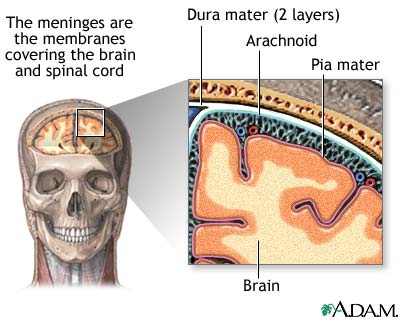

 Pathogenesis
Pathogenesis N. Meningitidis can be the cause of three major diseases. These three are nasopharyngitis, meningococcal septicemia, and meningococcal meningitis. Nasopharyngitis is usually a very short illness and sometimes there aren’t even any symptoms. It is found because it is what will occur before Meningococcal Septicemia. If the N. Meningitidis bacteria colonize in the nasopharynx and spread into the blood stream, the disease becomes known as Meningococcal Septicemia.
This disease has many symptoms including high fever, rash, arthritis, and problems with blood flow. The problems with blood flow usually result in skin lesions that look like dark red or purple splotches all over the body. The bacteria will eventually affect the adrenal glands and adrenal insufficiency quickly leads to death.
 The
most common disease caused by
Neisseria
Meningitidis is Meningococcal Meningitis or more
commonly known as bacterial meningitis.
It is also known as epidemic meningitis.
The disease usually comes on quickly with severe
headaches, high fever, pain and stiffness of the neck,
back, and shoulders and nausea follows shortly after all
of these initial symptoms.
The
most common disease caused by
Neisseria
Meningitidis is Meningococcal Meningitis or more
commonly known as bacterial meningitis.
It is also known as epidemic meningitis.
The disease usually comes on quickly with severe
headaches, high fever, pain and stiffness of the neck,
back, and shoulders and nausea follows shortly after all
of these initial symptoms.
Skin lesions have also been found in approximately 50% of patients that were diagnosed with bacterial meningitis. If the individual is able to survive the disease they may be left with life changing effects such as deafness, mental retardation, and behavior defects. The mortality rate of bacterial meningitis is 85% and the figure has stayed constant even with the discovery of many antibiotics.
Neisseria Meningitidis will attach to the microvilli of nonciliated columnar epithelial cells that reside in the nasal region of humans. The bacteria are able to multiply and form a colony because of its ability to acquire iron from the host. The bacteria are then able to invade the mucous membrane that lines the nasopharnyx. The bacteria eats through the mucous using a process similar to phagocytosis. Phagocytosis is defined as the engulfment and uptake of a small particle or cell by an extension of another cell’s plasma membrane. Neisseria Meningitidis then has access to the blood stream of the individual and from there usually move into the meninges of the brain.
If you think this is cool...go on to Diagnosis and Treatment!







